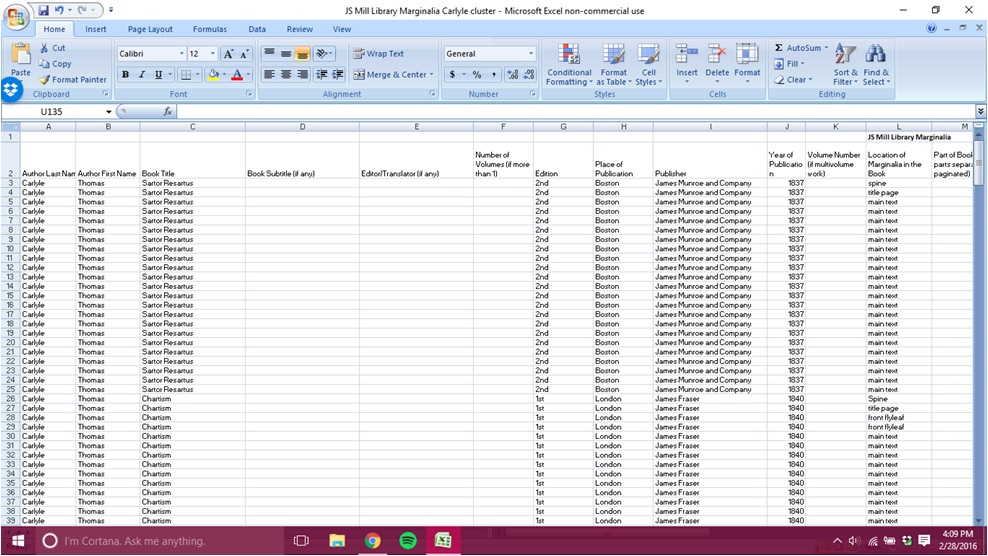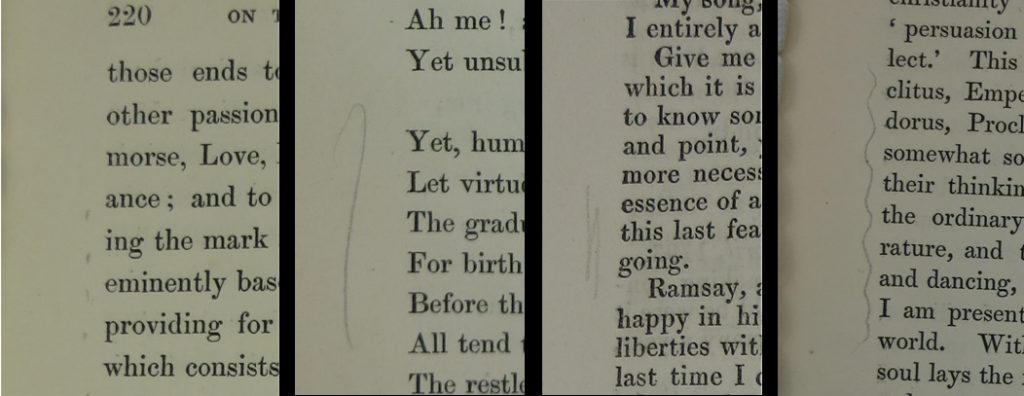Before I get into the details, a little about me: My name is Carissa Schreiber.

I love football and food. I graduated from the University of Alabama this May (2016) with an English major, and I currently live in New York. When I joined the project in August 2015, I had taken three consecutive courses with Dr. Pionke, so I was very excited about the opportunity to work with him on such an interesting research endeavor.
My most significant task involved filling spreadsheets with information about each example of marginalia.
The marginalia I transcribed came from Dr. Pionke’s photos, many of which had multiple marks on them. This came out to about 1400 individual examples. This seemed daunting at first (what if I missed one? what if I couldn’t read his writing?), but over time, I was able to get into a rhythm and get more familiar with the examples present.
I fell into a language of annotation, so much so that my own notes in books became suspiciously similar to Mill’s—somehow I assumed that I would remember my own meanings behind scores, dashes, and checkmarks. The jury’s still out on whether this was actually useful for me.
The data in the spreadsheets included basic information about the volumes, such as title, edition, publisher, etc. so that the marks can be traced back to the text they correspond to. This was the easy part—for each text, I could use Excel’s “fill” feature to copy endless lines of text.
The more complicated part was recording details about the writing instrument, location, and, of course, the actual transcriptions. As you can imagine, this wealth of information made for an intimidatingly large spreadsheet.

The marks varied from simple dashes to extensive notes about the content, and every mark meant a new line of information. There were pages with only faint marks, which took quite a while to notice and identify, and there were pages with several marks, which made me feel like I was getting a lot more done. I identified the type of writing instrument (Mill favors pencil), the type of mark, and counted lines of text so I could cite exactly where to find the mark. It was always nice to remember that my work meant the lack of work for final project users—and I’d imagine the sort of conclusions they could draw by analyzing Mill’s exclamation point and check mark usage throughout de Tocqueville volumes.
The transcriptions were generally fairly simple, but sometimes included distinguishing between very similar marks, such as these varying types of scores (dotted, tailed, corrugated, double, normal).

The naming of these specific marks also caused problems sometimes, going through several iterations—the corrugated score began as simply a “curved score,” then became “scalloped,” and finally “corrugated.” While I usually took the lead on these names, I always confirmed them with Dr. Pionke. The corrugated score in particular was so problematic to name that even he conferred with other members of the English department to create the perfect title.
Those 1400 marks were an adventure, a journey through the inner workings of J. S. Mill’s (very sassy) mind. I can’t wait to see what people are able to draw from such information, and I’m so glad I got to be a part of it.
– Carissa Schreiber, former Research Assistant to Professor Pionke at the University of Alabama.